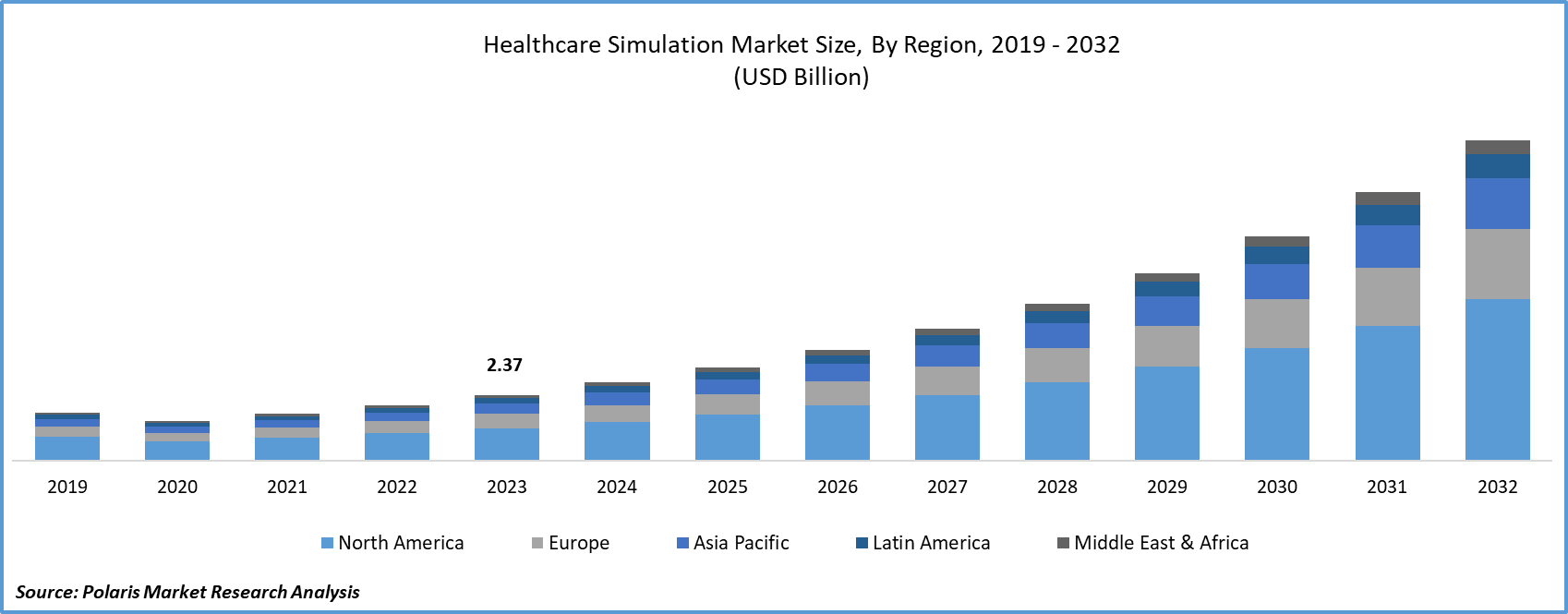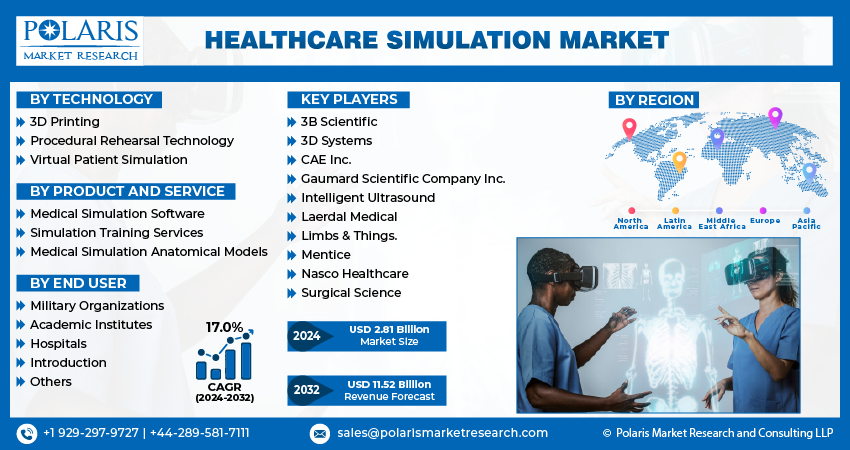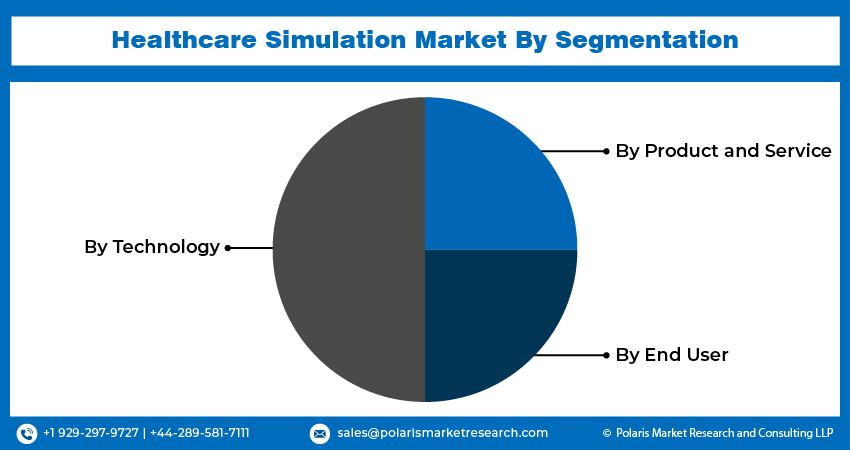
Healthcare Simulation Market Share, Size, Trends, Industry Analysis Report, By Technology (3D Printing, Introduction, Procedural Rehearsal Technology, Virtual Patient Simulation); By Product and Services; By End User; By Region; Segment Forecast, 2024- 2032
- Published Date:Mar-2024
- Pages: 118
- Format: PDF
- Report ID: PM4645
- Base Year: 2023
- Historical Data: 2019-2022
Report Outlook
Global healthcare simulation market size was valued at USD 2.37 billion in 2023. The market is anticipated to grow from USD 2.81 billion in 2024 to USD 11.52 billion by 2032, exhibiting a CAGR of 17.0% during the forecast period
Healthcare Simulation Market Overview
Healthcare simulation represents an advanced methodology for educating and training healthcare professionals, utilizing sophisticated educational technology. The terminology varies based on application, encompassing simulation in surgical simulation, patient simulation, healthcare, nursing simulation, and clinical simulation. Anatomical models, including patient simulators, interventional/surgical simulators, endovascular simulators, ultrasound simulators, and others, form the basis of most simulations. These simulators provide significant advantages over traditional learning methods, addressing challenges inherent in conventional approaches. Deployed extensively in hospitals, institutes, clinics, and research centers worldwide, anatomical models and training services allow practitioners to practice intricate medical procedures on a lifelike model with interchangeable organs before applying them to real-life patients, thereby enhancing the learning experience.

To Understand More About this Research: Request a Free Sample Report
The healthcare simulation market size is driven by the need to maintain regulatory compliance, the growing imperative to lower healthcare costs and the rising demand for patient-centric healthcare.
Additionally, the surge in the medical simulation market is fueled, in part, by the heightened utilization of simulation in the healthcare sector, an uptick in mortality resulting from medical errors, and the aspiration to enhance patient safety outcomes. Virtual and augmented reality, gaining popularity, have demonstrated their value in communication and training within healthcare simulation programs. For instance, virtual reality (VR) can facilitate distant collaboration among students on procedures such as surgeries, allowing them to apply their knowledge in practice and rectify errors. The integration of virtual and augmented reality serves as a valuable complement to hands-on training involving surgical procedures and the insertion of IVs in healthcare simulation.

Healthcare Simulation Market Dynamics
Market Drivers
Growing Need for Accurate Invasive Interventions.
Performing surgeries demands a high level of precision to ensure the safety of the patient. This need for precision becomes even more critical with the geriatric population. Surgeons, particularly, need extensive practice and experience gained through surgical simulation equipment to conduct surgeries safely. As the number of surgeries increases in various medical fields such as cardiac, orthopedic, and neurology, the demand for highly skilled and precise surgeons rises. Therefore, the use of surgical simulations is expected to increase the healthcare simulation market share over the forecast period.
Market Restraints
Inaccuracy in the use of manikins is likely to hamper the growth of the market.
Prior to engaging with actual patients, clinicians and researchers can practice and enhance their interpersonal and teamwork skills in a secure learning environment facilitated by healthcare simulation. Manikins find application in numerous simulation scenarios, allowing the induction of symptoms responsive to simulated treatments. Nevertheless, due to the complexity of human systems, models and instruments are limited in accurately replicating human functioning. Facilitators and simulation engineers face the challenge of building and adjusting simulation models to represent desired physiological responses under specific conditions faithfully. Manipulating these systems to achieve precise simulation goals can be intricate. Poorly designed simulators may lead to adverse learning experiences, potentially impacting future medical decision-making. While these factors might somewhat limit market expansion, their impact is expected to be constrained.
Report Segmentation
The market is primarily segmented based on technology, product and service, end user, and region.
|
By Technology |
By Product and Service |
By End User |
By Region |
|
|
|
|
To Understand the Scope of this Report: Speak to Analyst
Healthcare Simulation Market Segmental Analysis
By Product and Service Analysis
- The healthcare simulation market outlook analysis witnessed substantial growth in the web-based simulation segment during the forecast period. Key factors driving this expansion include the provision of controlled and predictable learning environments, regulated access to simulation procedures, and the ability for healthcare professionals to participate in remote training and education activities. This approach breaks down geographical barriers, offering convenient learning opportunities. This healthcare simulation market trend of increasing adoption of online and remote learning, driven by technological advancements and the global shift towards digital platforms, has contributed to the growing demand for web-based healthcare simulations.
By End User Analysis
- The hospital's segment is expected to demonstrate the highest growth rate in the healthcare simulation market report in 2023. This surge is attributed to the increasing emphasis on continuous professional development and the imperative to improve patient safety within clinical settings. Simulation technology facilitates healthcare professionals in hospitals to hone their skills, undergo training in complex procedures, and acquaint themselves with new medical technologies within a risk-free environment.
- The academic institutes and centers segment is experiencing rapid growth in the forecast period. This growth is driven by the increasing demand for testing real-life scenarios before engaging in critical operations. For instance, the National Institute of Diabetes and Digestive and Kidney Diseases (NIDDK) utilized PBPK modeling to study the impact of reduced kidney function on the pharmacokinetics of drugs eliminated primarily by organic anion transporters.

Healthcare Simulation Market Regional Insights
The North American region dominated the global market with the largest market share in 2023
Several U.S. companies are actively exploring the potential applications of technology to improve and modernize the healthcare sector. Key vendors are integrating computational modeling and simulation (CM&S), exploring various approaches to harness its capabilities for enhancing safety and fostering innovation in medical devices. In 2022, the University of the Virgin Islands and CAMLS collaborated to launch the first medical simulation facility. Similar to CAMLS in Tampa, the St. Croix simulation facility features over 21,000 square feet of trauma and hybrid operating theaters, 18 surgery skill lab sectors, patient exam rooms, a dining room, four team training rooms, and an auditorium. Beyond hosting training programs, conferences, and research, the new facility is expected to generate 500 new jobs.
Europe is poised for dynamic market growth in the forecast period. Simulation-based education (SBE) is increasingly becoming an integral component of post-graduate medical education in Europe, supported by national policies and medical literature bodies. The adoption rate is gaining momentum, particularly in European countries, with the U.K. leading in anesthetics and surgical training. The Society for Simulation in Europe (SESAM), dedicated to promoting and supporting healthcare simulation for training and research, plays a significant role in this trend. In 2020, VirtaMed introduced an innovative approach to medical training using cutting-edge healthcare simulation solutions. The first mobile surgical simulation lab in Switzerland embarked on a three-month tour, offering university hospitals risk-free training opportunities.

Competitive Landscape
The Healthcare Simulation market players are fragmented and are anticipated to witness competition due to several players' presence. Major service providers in the market are constantly upgrading their technologies to stay ahead of the competition and to ensure efficiency, integrity, and safety. These players focus on partnership, product upgrades, and collaboration to gain a competitive edge over their peers and capture a significant market share.
Some of the major players operating in the global market include:
- 3B Scientific
- 3D Systems
- CAE Inc.
- Gaumard Scientific Company Inc.
- Intelligent Ultrasound
- Laerdal Medical
- Limbs & Things.
- Mentice
- Nasco Healthcare
- Surgical Science
Recent Developments
- In November 2022, Gaumard Scientific Inc. reported the initial deployment of the HALS5301 conversational robotic patient simulator at the Emory Nursing Learning Center.
- In October 2022, Intelligent Ultrasound introduced BodyWorks Eve, designed for novice users to practice ultrasound skills. BodyWorks Eve, a female patient simulator, offers a highly realistic experience for interactive Point of Care Ultrasound scenario training.
Report Coverage
The Healthcare Simulation market report emphasizes key regions across the globe to provide a better understanding of the product to the users. Also, the report provides market insights into recent developments and trends and analyzes the technologies that are gaining traction around the globe. Furthermore, the report covers an in-depth qualitative analysis pertaining to various paradigm shifts associated with the transformation of these solutions.
The report provides a detailed analysis of the market while focusing on various key aspects such as competitive analysis, technology, product and service, end user, and their futuristic growth opportunities.
Healthcare Simulation Market Report Scope
|
Report Attributes |
Details |
|
Market size value in 2024 |
USD 2.81 billion |
|
Revenue Forecast in 2032 |
USD 11.52 billion |
|
CAGR |
17.0% from 2024 – 2032 |
|
Base year |
2023 |
|
Historical data |
2019 – 2022 |
|
Forecast period |
2024 – 2032 |
|
Quantitative units |
Revenue in USD billion and CAGR from 2024 to 2032 |
|
Segments Covered |
By Technology, By Product and Service, By End User, By Region |
|
Regional scope |
North America, Europe, Asia Pacific, Latin America; Middle East & Africa |
|
Customization |
Report customization as per your requirements with respect to countries, regions, and segmentation. |
FAQ's
The global Healthcare Simulation market size is expected to reach USD 11.52 billion by 2032
Key players in the market are 3B Scientific, 3D Systems, CAE Inc., Gaumard Scientific Company Inc., Intelligent Ultrasound
North American contribute notably towards the global Healthcare Simulation Market
Healthcare Simulation Market exhibiting a CAGR of 16.5% during the forecast period
The Healthcare Simulation Market report covering key segments are technology, product and service, end user, and region.
